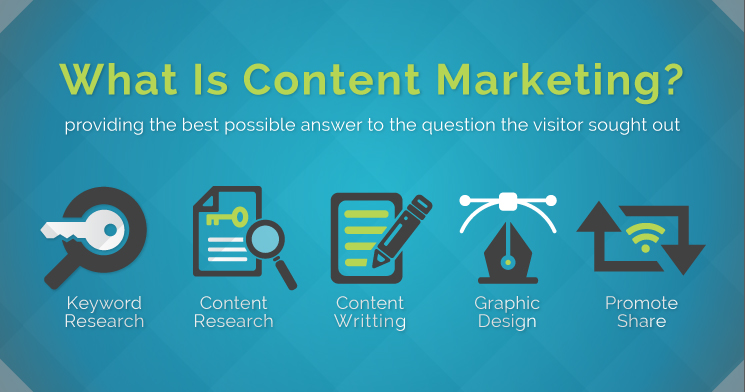Value content has become almost mandatory for companies that want to achieve more goals and provide better service to their customers. This is due to the fact that consumers are no longer satisfied with just knowing about the existence of a product or service. Today there are the necessary tools to investigate a brand or company before making a purchase.
Therefore, in this article, we will address the best content marketing strategies. This includes not only blog posts, but a whole structure of tools that are useful for consumers on a daily basis and that adapt to their requirements.
Content marketing is one that focuses on creating, publishing and distributing relevant content for your target audience, with the purpose of attracting new customers in a non-intrusive way.
Content Marketing Benefits

1. Generate leads on a sustained basis
Content marketing may seem like a lot of work to you, especially when compared to other marketing plans that offer immediate rewards, such as list buying, pay-per-click (PPC), or trade show marketing, where you get names and email addresses in just a few moments.
However, it is proven that content marketing generates three times more leads than traditional strategies and 72% of companies consider it an effective method of increasing leads. In other words, the content marketing plan prepares companies to have a predictable, scalable and effective flow of leads.
2. It is a less expensive strategy in the long term
Hiring the specialists who will bring your content strategy to life may seem expensive, but consumers review three to five pieces of content before contacting a marketer, so consider it an essential investment. In fact, 98% of marketers believe that content marketing performance is worth the investment.
3. Increase brand recognition
When you offer real value to your audience: you listen to them, you are aware of what they need to solve their pain points and you give them the information they need, your brand becomes relevant. Brand recognition is not something tangible or that can be measured in concrete terms, but it makes brands transcend and be the first choice of consumers.
Content marketing is an opportunity to increase the recognition of your brand with a varied and timely content offer, coupled with tactics such as branded content, email marketing and even properly targeted outbound strategies.
4. It is the input for an inbound strategy
Content marketing can be the door to an inbound strategy that revolutionizes the way you perceive your business and marketing in general. A well-organized content strategy will lead you to see that customers are the center of your company, and that it is not enough to want to sell them a product at all costs. You need to listen to them so that they come to you of their own free will, that they have valuable interactions with your brand for their daily life and that you accompany them beyond the moment of purchase.
This will not only lead you to generate more leads, increase your brand recognition or position yourself in a market, but it will also make your business grow and last ( even in times of crisis ).
Basic objectives of content marketing

1. Generate relevant and really useful content
Content marketing has the purpose of creating a relevant offer for the brand’s audience and providing them with useful information. Therefore, you must know it in depth through strategic tools that allow you to generate your buyer personas.
2. Make a brand known and reinforce its authority
Also, one of your goals is to gain recognition and build your authority online. In other words, their strategies are focused on making the public keep a brand in mind and, at the same time, that search engines like Google give preference to their content to display them.
3. Attract visitors
Generating web traffic is essential to achieve the sales objectives of a digital business. Content marketing focuses on attracting visitors, who, if they find the information they are looking for, will stay longer on the site and may return to it again.
4. Contribute to the acquisition of leads
Another task of content marketing is, in large part, that visitors become leads: that they give their contact information so that the company can send them more resources and, eventually, invite them to purchase. A good content marketing strategy will also attract more leads tailored to the brand.
78% of marketers say that content marketing increased lead acquisition in their businesses.
5. Nurture customer loyalty
The company’s existing customers also need information, so content marketing is responsible for filling their requirements and opening the door to the acquisition of new products or the renewal of a service. In the case of a pool care company, for example, a customer might learn about the benefits of an innovative cleaning method and so decide to purchase it, without pushing them to buy.
6. Maximize the profits of a business
Content marketing is a way to obtain profitability, because it offers new opportunities to sell your products or services. In addition, it requires an investment 62% less than traditional marketing.
Next, we will tell you how to integrate each type of content marketing into your strategy.
Most common types of content marketing
1. Blog Posts
Bloggers are usually the ones in charge of blogs. However, if your team is large enough and has someone dedicated to creating premium and private access materials (such as ebooks and tools), they could also write articles that help promote those resources.
SEO specialists must also work in tandem with bloggers, as blog posts are often the best opportunity a business has to improve its organic search rankings. Therefore, it is favorable that they write articles that improve the positioning of the website and increase both organic traffic and leads.
Also, publications should also consider keyword research because, with this, they will create content that is optimized for search engines.
2. Ebooks
Ebooks are publications that teach readers how to do something or provide information on a topic. These come in the form of tutorials, guides, or protocols for using a product or troubleshooting.
The ebook format is very popular, often shared in PDF files and accessed through a form or directly by visiting a website.
If you accompany your ebooks with practical tools, templates or pre-designed forms, you will show yourself willing to help your visitors. This resource has proven to be functional and excellent for generating long-term leads, which benefits the company despite the investment made to develop them.
3. Webinars
Webinars are another good option to attract an audience through talks, talks, or introductions to topics of interest. With this, you show that you know the market and you are interested in promoting learning among your followers.
This type of content is led by a subject matter expert, engaging their own audience, which can help you grow leads. In addition, webinar recordings can be hosted on a landing page (or landing page) and extend their useful life.
Remember to schedule them at a suitable time that suits the target audience and invite leaders in the sector to share their knowledge or experience.
4. Reports
Reports are the right resource to offer specialized information. These can be research, market or product studies and are shared in PDF files or on microsites, free or for a fee.
These premium materials are long-form and contain elements not found in a blog. Therefore, its use completes the task of generating leads and contacts or developing a brand.
In this case, bloggers can also participate in its development, since blog articles are a good compass to understand which topics work best among your visitors and deserve investment.
5. Podcast
Podcasts serve to connect with your audience through topics of interest to them, which are narrated from an expert point of view, but with a pleasant tone. This is essential because many of the consumers of this format listen to it in moments of distraction or while doing other activities.
These can be thought leadership, where your guests talk about the biggest changes in an industry and invite the listener to rethink their ideas. To create this type of content, you can take advantage of the experience of your colleagues and invite them to the program.
Another option is to make programs about high-impact news or current affairs in your sector: you will report on industry news and, in the same way, you will reflect on its relationship, not so obvious, with popular news.
6. Educational material
Knowledge is power and companies must provide it to their customers. Contrary to popular opinion, having an informed market makes every trade conscious and voluntary, which will make customer loyalty more genuine.
For this reason, companies must empower their audiences with the help of educational materials that, in addition to increasing their knowledge, will indirectly convince them to purchase a brand’s solutions. Thanks to them, the client will know that you care about their development and that they can grow by your side.
Whitepapers are a good example of educational material. These documents are simpler and more specific than guides or reports, which will help provide useful information without complicating it.
7. User Generated Content
Word of mouth marketing is one of the most important for companies. It occurs when consumers use their own communication platforms, such as social networks, to share content from a brand, refer to it in their publications or recommend a product.
This user-generated content can use videos, images, texts or posts on social networks. Although it is not produced by companies, its creation can be motivated by them through challenges.
These do not generate a direct expense for the companies, well, many times. Users do them as part of their own economic activities or, out of a genuine interest in sharing their experience regarding a brand. However, customers are expected to reflect what they really think about a brand.
8. Testimonials
Testimonials are often delivered in videos or personal blog posts. In them, content creators try a product or service and share their experiences, whether positive or negative.
These contents can also be reviews or brief comments that individuals use to give their opinion about a brand; They are distinguished from testimonials by their brevity.
Sometimes it is believed that testimonials are created by the user, but this is not necessarily true. For example, there are companies that commission video reactions or written testimonials of their products. If you find yourself in this scenario, remember not to bias the judgment of your product reviewers or force a positive testimonial.
9. Infographics
Infographics are visual and communication tools that are used to synthesize information and present it in a simple, concrete and attractive way. This resource can be integrated into your blog posts or shared on social media.
While designers do most of the complex creative work, bloggers, content creators, and social media managers can also get involved in simple designs.
Designers often create templates to give the team more independence, so anyone with an InDesign license can create infographics that make an impact on users.
10. Memes
Surely you have heard that laughter is the best medicine. Well, it’s also the best tool to engage consumers: images and videos created to entertain and amuse are a completely different type of content marketing.
The focus of these materials is to appeal to humor or trends beyond the market. Therefore, companies must have work teams that know the public well, the fashion references and the appropriate platforms to connect with them.
Memes are a very popular marketing resource today because they promote a more personal and simple connection with users through humor.


